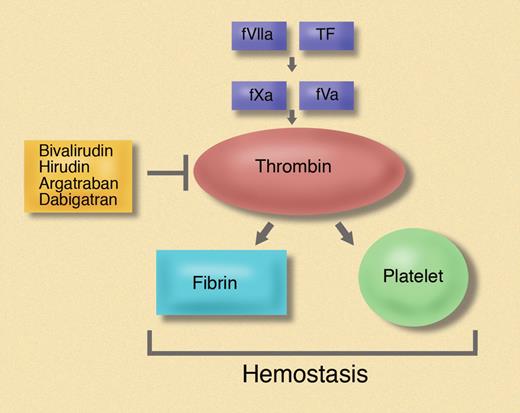In this issue of Blood, Mullins and colleagues show that genetic elimination of the prothrombin (fII) gene in adult mice leads to death within 7 days. Unexpectedly, instead of a uniform hemorrhage in all tissues, the mice exhibited a tissue-specific pattern of hemorrhage particularly in the heart and brain.
Hemostasis, the arrest of bleeding from an injured blood vessel, is mediated by binding of platelets (primary hemostasis) and activation of the coagulation cascade (secondary hemostasis). Genetic studies in mice have demonstrated that “knock-out” of components of the extrinsic coagulation pathway (tissue factor and fVII) or the common coagulation pathway (fX, fV and fII) is not compatible with life due to defective vessel formation during embryonic development and hemostatic defects after birth. 1 However, mice can survive without fibrinogen, the end point of the coagulation cascade, or without protease activated receptor 4 (PAR-4), which mediates thrombin activation of platelets in mice.2 Importantly, mice with a combined deficiency of both fibrinogen and PAR-4 die after birth due to uncontrolled hemorrhage.3 These observations are consistent with the notion that thrombin is the central serine protease in the coagulation cascade and plays critical roles in both cleavage of fibrinogen and activation of platelets.
The extrinsic and common coagulation pathways are essential for hemostasis. Formation of the fVIIa:tissue factor (TF) complex after vessel injury leads to activation of fX to fXa, which, together with its cofactor fVa, cleaves prothrombin to thrombin. Thrombin activates fV, fVIII, fXI, and fXIII, cleaves fibrinogen to fibrin, and activates platelets by cleavage of PARs. Direct thrombin inhibitors include bivalirudin, which is used in invasive cardiology, hirudin and argatraban, which are used to treat patients with heparin-induced thrombocytopenia and dabigatran, an orally available drug. Professional illustration by Marie Dauenheimer.
The extrinsic and common coagulation pathways are essential for hemostasis. Formation of the fVIIa:tissue factor (TF) complex after vessel injury leads to activation of fX to fXa, which, together with its cofactor fVa, cleaves prothrombin to thrombin. Thrombin activates fV, fVIII, fXI, and fXIII, cleaves fibrinogen to fibrin, and activates platelets by cleavage of PARs. Direct thrombin inhibitors include bivalirudin, which is used in invasive cardiology, hirudin and argatraban, which are used to treat patients with heparin-induced thrombocytopenia and dabigatran, an orally available drug. Professional illustration by Marie Dauenheimer.
The concept of hemostasis is easy to envisage in settings such as a knife cut where blood vessels are severed and the clotting system is activated by exposure to tissue factor. What is not considered by most people is that in daily life there are likely to be “spontaneous” breaks in blood vessels throughout the body. If one were to design a hemostatic system, it would be beneficial to provide a basic protection to all blood vessels, as well as additional protection to blood vessels in vital organs and organs in which blood vessels are more likely to be damaged by repetitive mechanical stress, such as the heart. Indeed, tissue factor is expressed by adventitial fibroblasts and vascular smooth muscle cells surrounding larger blood vessels and pericytes surrounding capillaries and thus provides basic hemostatic protection to all blood vessels. Tissue factor is also expressed in a tissue-specific manner, with high levels in the brain and heart. This pattern of expression is consistent with a design in which high levels of tissue factor provide additional hemostatic protection to these vital organs. Support for this idea was first provided by the observation that mice engineered to express very low levels of tissue factor (∼1%) exhibited tissue-specific hemostatic defects, particularly in the heart.4,5 Similar hemostatic defects were observed in mice expressing very low levels of fVII (∼1%) and low levels of fX (approximately 5.5%).4,6 In contrast, mice lacking either fVIII or fIX survive to adulthood and have no hemostatic defects in their hearts. However, patients with hemophilia A (fVIII deficiency) or hemophilia B (fIX deficiency) often experience spontaneous hemorrhages in tissues with low levels of tissue factor expression (ie, joints and skeletal muscle) and have excessive hemorrhage after injury. These observations indicate that the extrinsic and common coagulation pathways but not the intrinsic pathway are important for cardiac hemostasis.
In this issue of Blood, Mullins and colleagues use the poly I:C-inducible Mx1-Cre system to genetically eliminate FII in adult mice. This is an elegant approach to study the role of fII in hemostasis. As expected, loss of fII was associated with a profound effect on the prothrombin time and the activated partial prothrombin time. Administration of poly I:C led to a rapid reduction in circulating fII levels and uniform death of the mice within 7 days. If one believes that hemostasis is equal in all tissues, one would expect hemorrhage in the majority of organs in these mice. Rather, the exciting observation in this report is that mice lacking circulating fII exhibit tissue-specifichemorrhage. Postmortem analysis of 39 mice revealed that the majority had cardiac hemorrhage, and approximately 50% had intracranial hemorrhage. Mice expressing low levels of fII (10%-20%) also had a mild hemostatic defect in their hearts at 1 year of age. The phenotype of these acute and chronic fII-deficient mice is remarkably similar to the phenotypes of mice with low levels of tissue factor, fVII and fX. Pharmacological inhibition of tissue factor in mice also leads to hemorrhage in the heart and brain.7 These studies support the idea that hemostasis is not equal in all tissues.
Anticoagulant therapy is designed to reduce thrombosis without affecting hemostasis. However, not surprisingly, the major side effect of anticoagulant drugs is hemorrhage. New anticoagulants have been developed that selectively target thrombin or fXa. 8 The current study demonstrates that pharmacologic reduction in thrombin activity below a critical threshold could compromise cardiac and brain hemostasis.
Conflict-of-interest disclosure: The author serves as a consultant for Daiichi-Sankyo. ■
REFERENCES
National Institutes of Health


